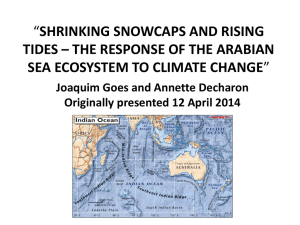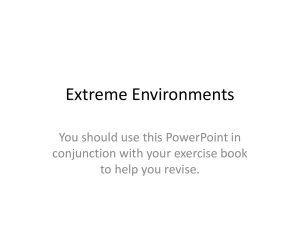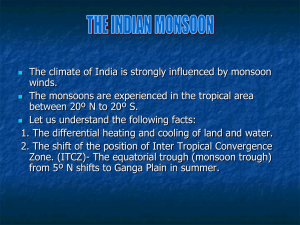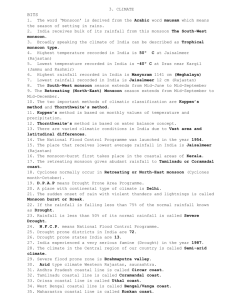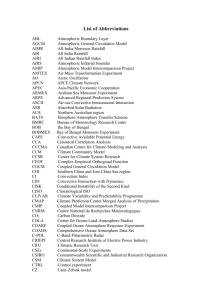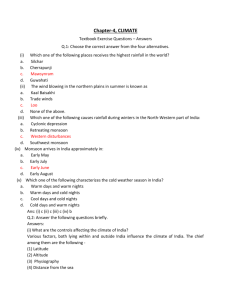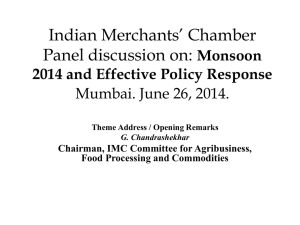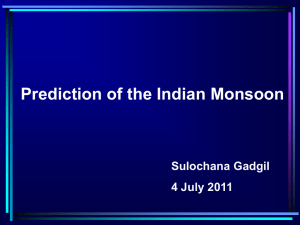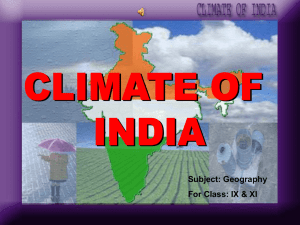CLIMATE OF INDIA
advertisement
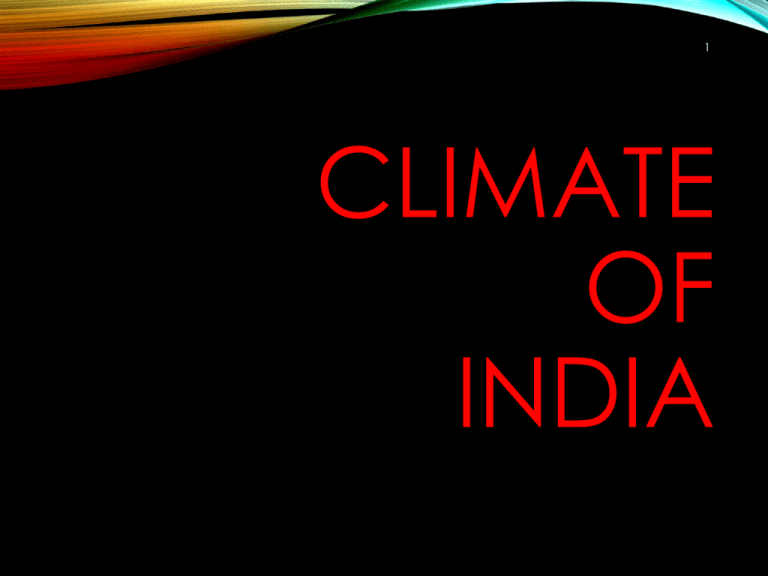
1 CLIMATE OF INDIA 2 CLIMATIC EXTREMES - TEMPERATURE o •55 C • Rajasthan on a hot summer day o •-50 C • Ladakh on a winter dawn 3 CLIMATIC EXTREMES RAINFALL •>2500 cm • Mawsynram (Meghalaya) •<13 cm • Thar desert 4 CLIMATIC EXTREMES – ANNUAL RANGE OF TEMPERATUTE o •3 C • Malabar Coast o •20 C • Interior India (Delhi) 5 SO, WHAT’S COMMON ? • The entire sub-continent receives rainfall due to Monsoon winds 6 FACTORS AFFECTING CLIMATE OF INDIA 1. Latitude 2. Physical features 3. Altitude 4. Distance from the Sea 5. Other minor factors 7 INFLUENCE OF LATITUDE • Tropic of Cancer passes through India • Northern half – Temperate • Southern Half – Torrid • Yet the sub-continent is said to have a sub-tropical climate!!! • No striking difference of temperature • Seasonal rainfall due to monsoons 8 INFLUENCE OF RELIEF HIMALAYAS • Himalayas • Stop cold winds from north • Help to create HT-LP regime • Pull monsoons • Force monsoons to shed moisture in India • Arakan Yoma Range • Deflect the monsoons into India 9 INFLUENCE OF RELIEF – OTHER FEATURES • Western Ghats • Uneven rainfall in the peninsula • Aravallis • Dry climate in Rajasthan 10 INFLUENCE OF ALTITUDE • Deccan Plateau cooler than Northern Plains in summer • Snowfall in Himalayas 11 DISTANCE FROM THE SEA • Equable climate in coastal areas • Extreme climate in the interior 12 OTHER FACTORS • Western disturbances • Winter Rainfall in Punjab • Conditions surrounding the sub-continent • Indian Ocean • Africa • Jet Streams • Not much known Seasons in India 13 14 15 March to May Sun directly overhead on equator on March 21 Sun directly overhead on Tropic of Cancer on June 21 16 From March to May (Movement of sun from Equator to Tropic of Cancer) High temperature, low pressure over the northern plains Low temperature, slightly high pressure over the Peninsular Plateau High pressure over Indian Ocean 17 Monsoon winds not drawn into India due to HP over Peninsula Hot ‘Loo’ in northern plains Kalbaisakhi in West Bengal Mango Showers in Kerala LOO THE INDIAN SUMMER March to May LP KALBAISAKHI HP MANGO SHOWER HP HP 19 THE INDIAN MONSOON 20 MONSOON – MEANING • Refers to a seasonal wind which blows over the Indian sub-continent • Sea to land in summer • Land to sea in winter 21 MONSOON – UNIQUE FEATURES • Brings rains to the sub-continent • Varies in strength • Uncertain and Uneven 22 MONSOON - TIMELINE • June to September • Sun moves from Tropic of Cancer to Equator • Causes LP in peninsular India • By August, monsoon spreads all over India 23 MONSOON – ARRIVAL TIMES • Monsoon arrival dates • Western Ghats, NE states – 15th June • North-western India, Eastern Ghats – 1st July • Northern Plains, Central India – 15th July • Kanyakumari is the first place to receive rainfall • Kerala is the first state to receive rainfall THE INDIAN MONSOON JUNE TO SEP LP LP HP HP 25 MECHANISM OF MONSOONS 26 DISTRIBUTION OF RAINFALL • Areas of Heavy Rainfall (>200 cm) • Windward Side of Western Ghats • Eastern Himalayas • West Bengal • Areas of Moderately heavy rainfall (100-200 cm) • Deccan Plateau • Middle Ganga Valley • Orissa 27 DISTRIBUTION OF RAINFALL • Areas of Moderate Rainfall (50-100 cm) • Eastern Ghats • Upper Ganga VAlley • Gujarat, Punjab, Rajasthan • Areas of Scanty Rainfall (<50 cm) • Western Rajasthan • Northern J & K • Kutch 28 Rainfall Distribution Map of India 29 FEATURES OF INDIAN RAINFALL • Occurs from June to September • Distinct Rainy Season • Erratic and unpredictable • Unevenly distributed • Orographic rainfall • Cyclones and convectional rainfall 30 THE RETREATING MONSOON Retreating Monsoon - Meaning 31 ► Strength of monsoon decreases ► Extent to which monsoons were able to reach from June to September decreases ► Direction remains the same ► Also called ‘Retreating SW Monsoon’ Retreating Monsoon - Causes ► Sun 32 moves from Equator towards Tropic of Capricorn ► Temperatures drop ► LP replaced by HP Retreating Monsoon - Dateline 33 ► October and November ► Monsoon withdrawal dates Northern Plains – 15th September Western Ghats – 1st October Kolkata – 15th October Kerala – 15th November Retreating Monsoon - Summary 34 ► Monsoons decrease in intensity ► LP gradually replaced by HP ► In the northern plains, it is oppressively hot – a condition called ‘October Heat’ ► Cyclones hit east coast and Bangladesh ► Kerala last state from where monsoons withdraw THE RETREATING MONSOON OCT AND NOV LP LP HP HP 36 WINTERS OF INDIA 37 The Indian Winter - Dateline November to February Sun descends towards Tropic of Capricorn THE INDIAN WINTER WESTERN DISTURBANCES DEC TO FEB HP HP NORTH EAST MONSOON LP LP 39 WINDS IN WINTER • Although India lies in Trade Wind Belt, • Himalayas & Arakan Yoma Ranges do not allow them to come to India 40 WINDS IN WINTER • • • • • • • HP over Land, LP over Sea Winds move from Land to Sea Deflected due to Coriolis Effect Blow from NE to SW Called NE monsoon winds Direction coincides with Trade Winds SW Monsoon winds ‘reverse’ in direction 41 Summary of Indian Winter Cool and Pleasant December to February Sun shines in the Southern Hemisphere HP over land; LP over Sea Winds move from Land to Sea (North East Monsoons) – a phenomenon called ‘Reversal of Winds’ 42 Summary of Indian Winter Western Disturbances come to India Cause cyclonic rainfall in Punjab Move along the foothills of the Himalayas into the Bay of Bengal NE Monsoons joined by Western Disturbances cause rainfall in Tamil Nadu (Palni, Javadi and Shevaroy hills)


